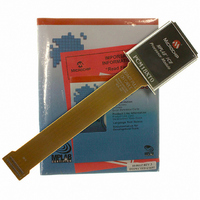PCM18XT0 Microchip Technology, PCM18XT0 Datasheet - Page 357

PCM18XT0
Manufacturer Part Number
PCM18XT0
Description
MODULE PROC PIC18F4685
Manufacturer
Microchip Technology
Datasheet
1.PCM18XT0.pdf
(484 pages)
Specifications of PCM18XT0
Accessory Type
Processor Module
Product
Microcontroller Modules
Core Processor
PIC18F4685
Lead Free Status / RoHS Status
Not applicable / Not applicable
For Use With/related Products
ICE2000
For Use With
ICE2000 - EMULATOR MPLAB-ICE 2000 POD
Lead Free Status / RoHS Status
Lead free / RoHS Compliant, Not applicable / Not applicable
- Current page: 357 of 484
- Download datasheet (9Mb)
24.3
The Two-Speed Start-up feature helps to minimize the
latency period from oscillator start-up to code execution
by allowing the microcontroller to use the INTRC
oscillator as a clock source until the primary clock
source is available. It is enabled by setting the IESO
Configuration bit.
Two-Speed Start-up should be enabled only if the
primary oscillator mode is LP, XT, HS or HSPLL
(Crystal-based modes). Other sources do not require
an OST start-up delay; for these, Two-Speed Start-up
should be disabled.
When enabled, Resets and wake-ups from Sleep mode
cause the device to configure itself to run from the
internal oscillator block as the clock source, following
the time-out of the Power-up Timer after a Power-on
Reset is enabled. This allows almost immediate code
execution while the primary oscillator starts and the
OST is running. Once the OST times out, the device
automatically switches to PRI_RUN mode.
Because the OSCCON register is cleared on Reset
events, the INTOSC (or postscaler) clock source is not
initially available after a Reset event; the INTRC clock
is used directly at its base frequency. To use a higher
clock speed on wake-up, the INTOSC or postscaler
clock sources can be selected to provide a higher clock
speed by setting bits, IRCF2:IRCF0, immediately after
FIGURE 24-2:
© 2009 Microchip Technology Inc.
Two-Speed Start-up
Note 1:
CPU Clock
Multiplexer
PLL Clock
Peripheral
INTOSC
Program
Counter
Output
OSC1
Clock
Wake from Interrupt Event
T
OST
TIMING TRANSITION FOR TWO-SPEED START-UP (INTOSC TO HSPLL)
= 1024 T
PC
OSC
; T
Q1
PLL
T
OST
= 2 ms (approx). These intervals are not shown to scale.
(1)
Q2
PIC18F2682/2685/4682/4685
PC + 2
T
OSTS bit Set
Q3
PLL
(1)
Q4
Reset. For wake-ups from Sleep, the INTOSC or
postscaler clock sources can be selected by setting the
IRCF2:IRCF0 bits prior to entering Sleep mode.
In all other power-managed modes, Two-Speed Start-up
is not used. The device will be clocked by the currently
selected clock source until the primary clock source
becomes available. The setting of the IESO bit is
ignored.
24.3.1
While using the INTRC oscillator in Two-Speed Start-up,
the device still obeys the normal command sequences
for entering power-managed modes, including serial
SLEEP instructions (refer to Section 3.1.4 “Multiple
Sleep Commands”). In practice, this means that user
code can change the SCS1:SCS0 bit settings or issue
SLEEP instructions before the OST times out. This would
allow an application to briefly wake-up, perform routine
“housekeeping” tasks and return to Sleep before the
device starts to operate from the primary oscillator.
User code can also check if the primary clock source is
currently providing the device clocking by checking the
status of the OSTS bit (OSCCON<3>). If the bit is set,
the primary oscillator is providing the clock. Otherwise,
the internal oscillator block is providing the clock during
wake-up from Reset or Sleep mode.
Q1
1
Transition
2
Clock
n-1 n
SPECIAL CONSIDERATIONS FOR
USING TWO-SPEED START-UP
PC + 4
Q2
Q3 Q4
Q1
PC + 6
DS39761C-page 357
Q2
Q3
Related parts for PCM18XT0
Image
Part Number
Description
Manufacturer
Datasheet
Request
R

Part Number:
Description:
Manufacturer:
Microchip Technology Inc.
Datasheet:

Part Number:
Description:
Manufacturer:
Microchip Technology Inc.
Datasheet:

Part Number:
Description:
Manufacturer:
Microchip Technology Inc.
Datasheet:

Part Number:
Description:
Manufacturer:
Microchip Technology Inc.
Datasheet:

Part Number:
Description:
Manufacturer:
Microchip Technology Inc.
Datasheet:

Part Number:
Description:
Manufacturer:
Microchip Technology Inc.
Datasheet:

Part Number:
Description:
Manufacturer:
Microchip Technology Inc.
Datasheet:

Part Number:
Description:
Manufacturer:
Microchip Technology Inc.
Datasheet:










